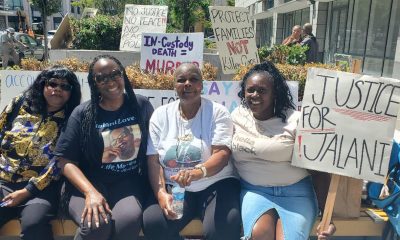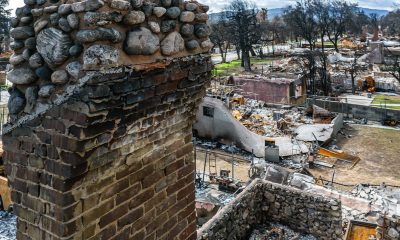Activism
City Begins Wood Street Homeless Encampment Clearance and Faces Protest

On Nov. 5 and 6, the City of Oakland began a clearance operation of a homeless encampment on a privately owned tract of land west of Wood St in West Oakland and were met with local residents who protested against displacing homeless people.
“I’ve developed relationships with people that live there and I understand that their situation is precarious,” said local resident Dale Smith, who protested on Nov. 6. “I don’t think the solution the city is putting forth is going to work.”
The city plans to eventually clear the lot, which runs about quarter mile from north to south. Oakland residents have lived there for over five years in vehicles, tents and self-made structures. No one knows exactly how many people live on the site, but most residents claim there are over 100. The lot has become more crowded recently as residents have been evicted from other areas of the city. Some residents claim that police officers directed them to the site.
“The city has been reviewing the idea of converting this privately owned lot to a safe RV parking area that would serve West Oakland RV dwellers,” said assistant city administrator Joe DeVries, “but the owner would need to clean it thoroughly first.”
The land is owned by a corporation called GameChanger LLC, but the city hasn’t stated who the individual owner is. The East Bay Times has reported that GameChanger LLC’s owner agreed to lease the land to the city for the next two to three years free of charge. As the city’s stated goal for Nov. 5 and 6 was to clear all vehicles from the site, GameChanger also agreed to pay the estimated quarter million dollar towing bill to the city.
The city’s communication director, Karen Boyd, claims OPD identified 139 vehicles that needed to be towed. Although the majority of the vehicles were abandoned, many of the lot’s RVs, vans, and buses serve as homes for people who are unable to afford housing in Oakland.
Past Oakland homeless clearances and evictions have resulted in people losing their vehicle-homes to impound lots. The poorest of the poor were especially vulnerable to these losses, as vehicle-homes that no longer ran were most likely to be impounded. Since many of the lot’s residents had been evicted before and lost their vehicle-homes, they, and the protestors supporting them feared they would lose them again.
On Nov. 5, over 35 housed protestors joined their unhoused neighbors, held signs and chanted “shame” and “quit your jobs” as police officers walked through the lot, directing people out of the way so tow operators could tow vehicles. Some of the signs read “Don’t tow our homes,” “Stop the evictions,” and “Ayuda no destruye,” which means “help don’t destroy” in Spanish.
After word spread that during the present clearance vehicles that served as people’s homes would be towed off the lot and unto Wood Street, as opposed to impound lots, the number of protestors dwindled, though homeless people and their housed supporters were still unhappy with the move. Around a dozen protestors showed up on Nov. 6.

Natasha Noel, a lifelong Oakland resident who was evicted from her home of 17 years, sits in front of her RV with a sign rested on it that says “I live here. this is my home.” Photo by Zack Haber
“It’s more of a safety zone in here and out on streets it’s more public,” said Jennifer ‘Harley’ Boslar, who was forced to move from the lot, “I feel like accidents can happen. A car could run into your RV. A semi-truck could run into your RV. People can get easier access to your RV than they can behind the fence.”
Wood Street, where many of the vehicles were moved, is a major route for big rig trucks. The Wood Street lot sits behind a fence with two small entrances, so residents have an easier time monitoring who approaches their vehicle-homes.
As of the night of Nov. 6, 15 vehicle-homes remain on the site. Police were unclear about when the remaining vehicles would be moved as the clearance was only originally planned to be a two day operation.
Natasha Noel, who grew up in Oakland and was recently evicted from her home of 17 years, still lives in an RV on the site and wants to stay there.
“I don’t feel like [moving] is a safe option at all,” said Noel. “On the street we’re likely to be towed at any second.”
Activism
Oakland Post: Week of November 26 – December 2, 2025
The printed Weekly Edition of the Oakland Post: Week of November 26 – December 2, 2025
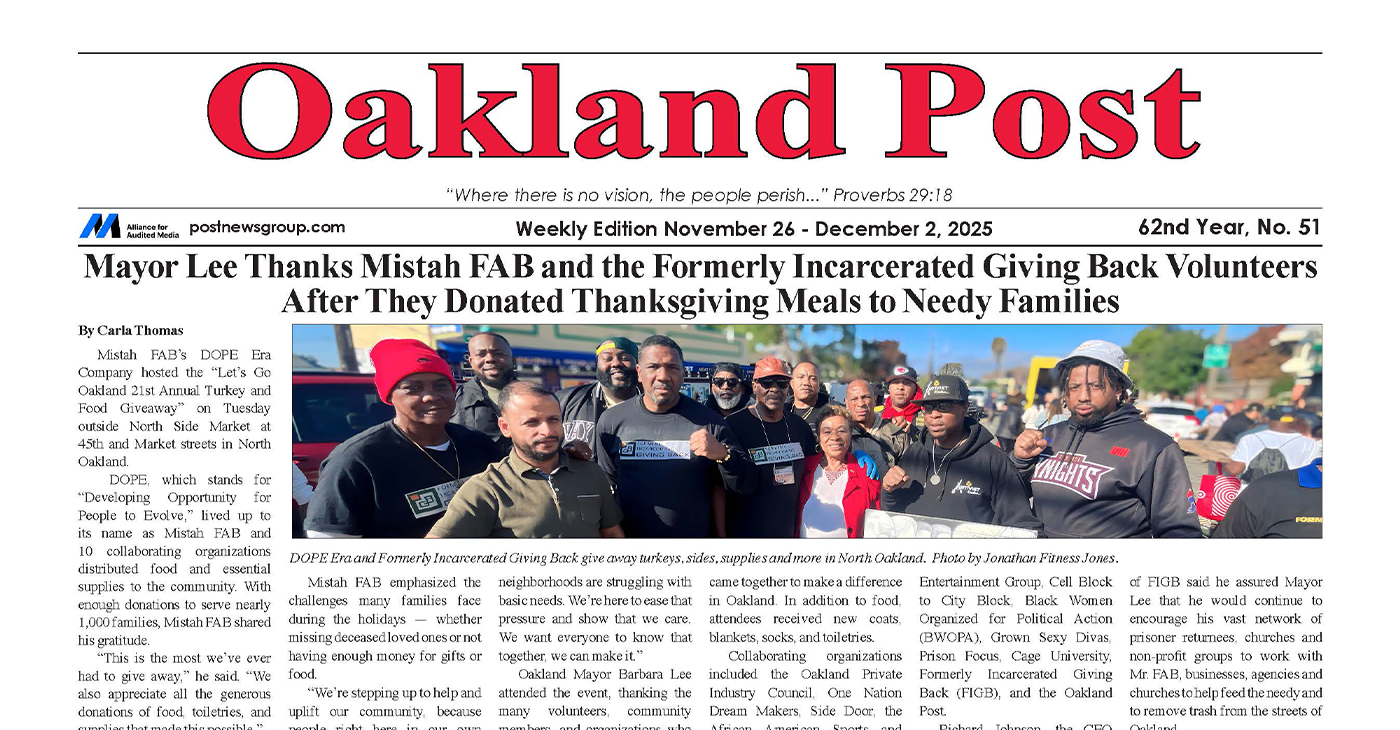
To enlarge your view of this issue, use the slider, magnifying glass icon or full page icon in the lower right corner of the browser window.
Activism
Oakland Post: Week of November 19 – 25, 2025
The printed Weekly Edition of the Oakland Post: Week of November 19 – 25, 2025
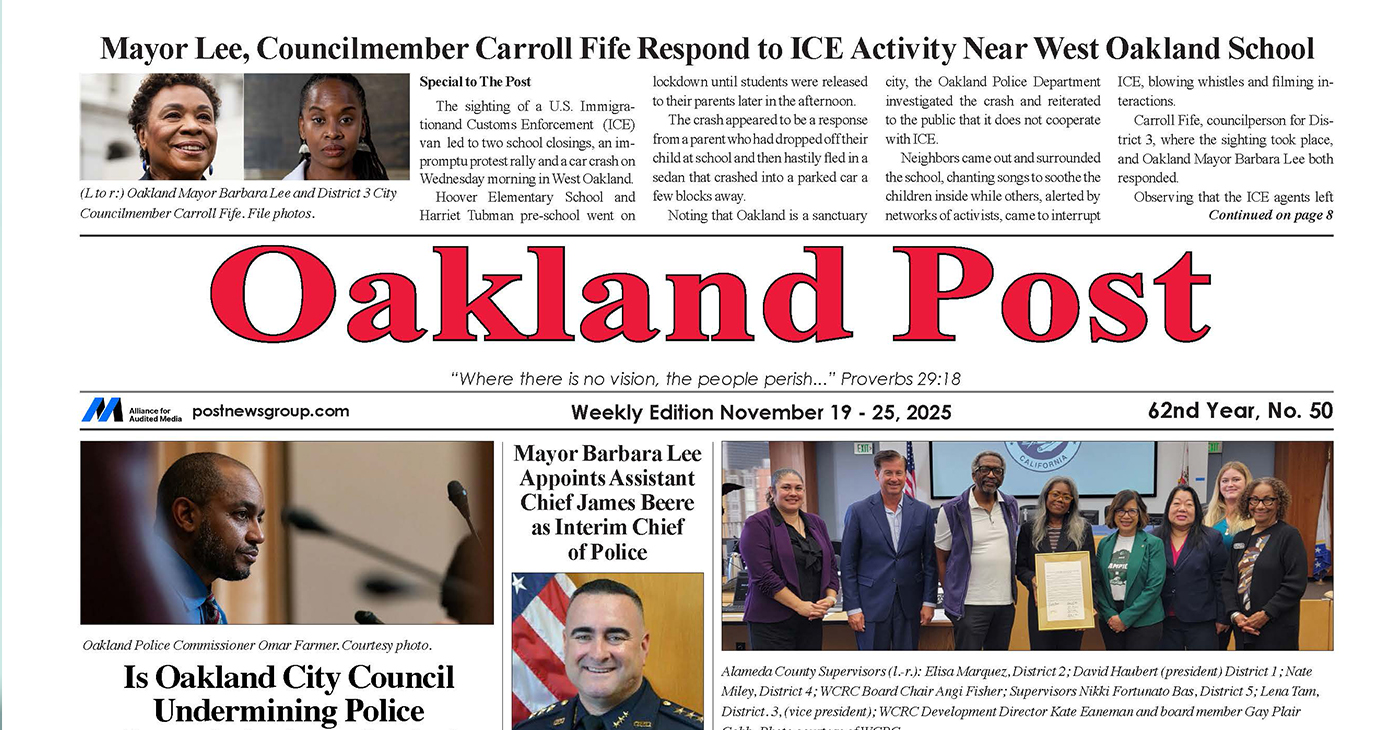
To enlarge your view of this issue, use the slider, magnifying glass icon or full page icon in the lower right corner of the browser window.
Activism
IN MEMORIAM: William ‘Bill’ Patterson, 94
Bill devoted his life to public service and education. In 1971, he became the founding director for the Peralta Community College Foundation, he also became an administrator for Oakland Parks and Recreation overseeing 23 recreation centers, the Oakland Zoo, Children’s Fairyland, Lake Merritt, and the Henry J. Kaiser Convention Center.

William “Bill” Patterson, 94, of Little Rock, Arkansas, passed away peacefully on October 21, 2025, at his home in Oakland, CA. He was born on May 19, 1931, to Marie Childress Patterson and William Benjamin Patterson in Little Rock, Arkansas. He graduated from Dunbar High School and traveled to Oakland, California, in 1948. William Patterson graduated from San Francisco State University, earning both graduate and undergraduate degrees. He married Euradell “Dell” Patterson in 1961. Bill lovingly took care of his wife, Dell, until she died in 2020.
Bill devoted his life to public service and education. In 1971, he became the founding director for the Peralta Community College Foundation, he also became an administrator for Oakland Parks and Recreation overseeing 23 recreation centers, the Oakland Zoo, Children’s Fairyland, Lake Merritt, and the Henry J. Kaiser Convention Center.
He served on the boards of Oakland’s Urban Strategies Council, the Oakland Public Ethics Commission, and the Oakland Workforce Development Board.
He was a three-term president of the Oakland branch of the NAACP.
Bill was initiated in the Gamma Alpha chapter of Kappa Alpha Psi Fraternity.
In 1997 Bill was appointed to the East Bay Utility District Board of Directors. William Patterson was the first African American Board President and served the board for 27 years.
Bill’s impact reached far beyond his various important and impactful positions.
Bill mentored politicians, athletes and young people. Among those he mentored and advised are legends Joe Morgan, Bill Russell, Frank Robinson, Curt Flood, and Lionel Wilson to name a few.
He is survived by his son, William David Patterson, and one sister, Sarah Ann Strickland, and a host of other family members and friends.
A celebration of life service will take place at Henry J. Kaiser Convention Center (Calvin Simmons Theater) on November 21, 2025, at 10 AM.
His services are being livestreamed at: https://www.facebook.com/events/1250167107131991/
In lieu of flowers, donations can be made to the Euradell and William Patterson scholarship fund TBA.
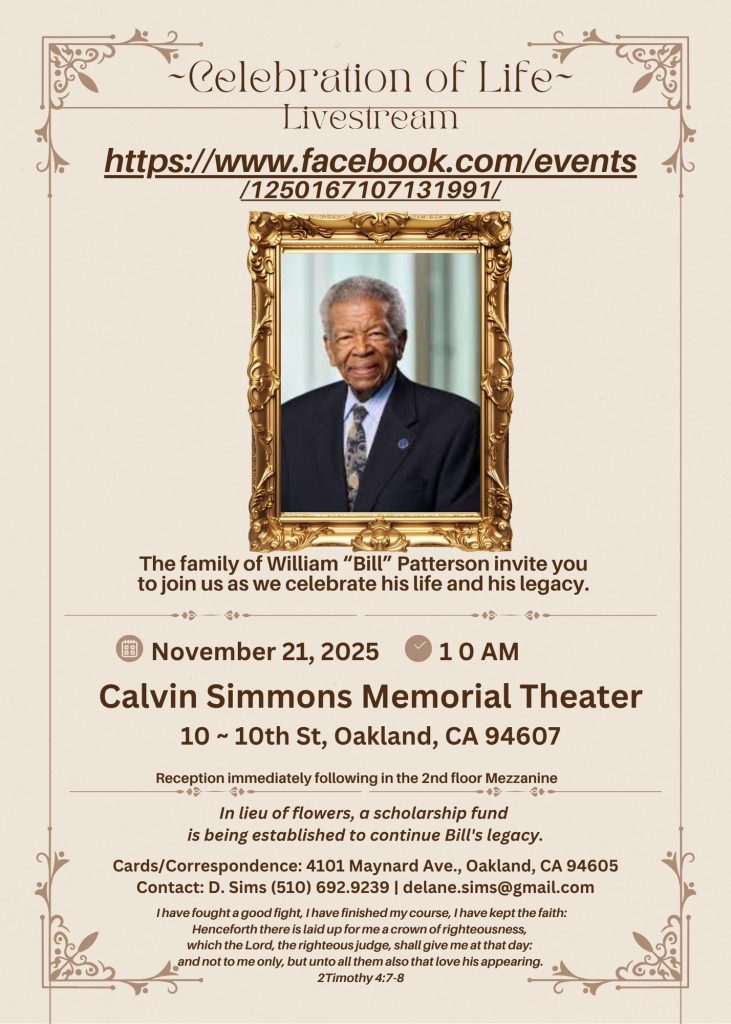
-

 Activism4 weeks ago
Activism4 weeks agoOakland Post: Week of November 5 – 11, 2025
-

 Activism3 weeks ago
Activism3 weeks agoOakland Post: Week of November 12 – 18, 2025
-

 Activism2 weeks ago
Activism2 weeks agoIN MEMORIAM: William ‘Bill’ Patterson, 94
-

 Activism3 weeks ago
Activism3 weeks agoHow Charles R. Drew University Navigated More Than $20 Million in Fed Cuts – Still Prioritizing Students and Community Health
-

 #NNPA BlackPress3 weeks ago
#NNPA BlackPress3 weeks agoThe Perfumed Hand of Hypocrisy: Trump Hosted Former Terror Suspect While America Condemns a Muslim Mayor
-

 #NNPA BlackPress3 weeks ago
#NNPA BlackPress3 weeks agoProtecting Pedophiles: The GOP’s Warped Crusade Against Its Own Lies
-

 Bay Area3 weeks ago
Bay Area3 weeks agoNo Justice in the Justice System
-

 #NNPA BlackPress4 weeks ago
#NNPA BlackPress4 weeks ago2026 Subaru Forester Wilderness Review: Everyday SUV With Extra Confidence

